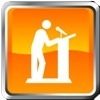Presentation Tips
The key element in a successful presentation is the presenter. Your ability to organize your thoughts, get your message across, and win over your audience will determine the ultimate success of the presentation.
Effective presentations do the following: 
- Focus on key ideas.
- Explain those ideas clearly and succinctly.
- Give a visual aspect to the words.
- Provide the audience with a visual image to connect to the message.
- Persuade the audience.
Defining your objectives
A good way to define your objectives is to follow this checklist:
- Determine your audience.
- Who are they?
- What background information do they have?
- What background information do they need?
- Determine your goals.
- What do you wish to accomplish?
- Is there a critical time frame?
- State the critical ideas you want your audience to accept.
- List the information you wish your audience to learn.
- Choose the visual aids you wish to use.
- Identify the means by which you can measure your success.
Outline your Presentation
The five most important questions to be answered in your presentation are the five Ws: Who, What When, Why, and Where . Determine the answers to those five questions, and then assemble your comments in a clear, straightforward, and logical manner. Keep your words and concepts simple and concise. Make sure you speak in a language that your audience understands and which is targeted to their level of knowledge. Introduce your ideas, support your ideas, reiterate your ideas.
Choose your graphics carefully so that they enhance your message rather than detracting from it or distracting your audience. Specific images which relate to your special concepts or products are especially useful.
Using an outline will be very beneficial. There are several formats you can use to lay it out. Storyboards are very handy because they permit you to assign your graphic images to your ideas early in the planning process. If you dont have access to a storyboard template, simple index cards are sufficient. Just use one side of the card for the text and the other side for your graphic.
When laying out your outline, consider following this guideline:
*Title - Short and to the point, it should reveal the focus of the presentation
*Introduction - Introduce the subject matter
*Purpose
*Goals
*Key Points - Provide concrete information to support the message
- Major Point 1 - Supporting information and visual aids
- Transition
- Major Point 2 - Supporting information and visual aids
- Transition
- Major Point 3 - Supporting information and visual aids
*Recap and Conclusion - Restatement of the presentations message and brief summary of major points.)
*Call to Action / Take home message - Charge the audience with the need to act based on your conclusions.
Creating the Presentation
The most successful presentations rely on a consistent and clear look. That is most easily achieved through the use of templates. All of the presentation packages come with generic templates. Many of them permit you to design your own template. In either case, your presentation will have far greater impact with a logo or other graphic symbol in the standard header of your template. Then, intersperse one or two graphics among your charts that relate specifically to the idea presented. A graphic representation of a new product alongside a graph of results with that product is useful and focusing.
Use contrasting (analogous) colours. Black on white or white on black is the best. Be aware of colour-blind members of the audience, so avoid mixing red and green on the same slides, particularly in charts and diagrams. See here for more info
Use consistent colors, fonts, and sizes throughout your presentation. Limit each slide to one or two graphic images, three or four contrasting colors, and one or two different text styles.
Do not place text in more than 70% of the available space in your slide or screen.
Try find out as much as possible about the room and audience size you will be presenting to. A dark background with light text is better suited to a lighter room. If the audience is in a large room images and text will need to be suitably large.
Images:
Use images and video to demonstrate a point or compliment your text. There is a fine line between comic and a professional impression. Don't use images just for decoration.
If you copy images from the internet it is common courtesy and good practice to acknowledge the website from which you obtained the image. Many websites have a Creative Commons disclaimer, which means you can use the images, as long as you acknowledge and link to the original source.
Videos:
Avoid using video in Powerpoint wherever possible, unless you are completely familiar with the linking system used in Powerpoint.
Keynote (Apple Mac) does embed videos in the presentation, like images, so it is more reliable.
A useful page for problems with video in Powerpoint - click here .
The Delivery 
Once you have created the best possible visual aids for your presentation, you are ready to put on your show. Familiarise yourself with your information and the visual aids you will use to convey your ideas. If possible, do a run through without looking at the slides or screens to make sure you know your pitch from start to finish. Do a dress rehearsal, if possible, to ensure that there are no unexpected glitches.
Get to the conference room early and do a trial run on your presentation, looking at the slides from the back of the room in the same light that will be used during the actual presentation.
Familiarise yourself with the light and ambience controls for the room, so that you can adjust these appropriately for your presentation or request the correct lighting.
Position yourself so that all audience members can see the screen and you clearly. Try avoid hiding behind a lecturn and keep you arms free to gesture.
(have a few ready)RELAX and let your enthusiasm for your concept shine. Encourage your audience to participate with you by asking them questions. Gauge their response to you regularly and speed up or slow down as necessary. If your audience looks bored, make a little joke(have a few prepared) to break up the mood.
Dont forget to summarize and give a few key learning points or take home messages at the end!
Good Luck!
![]()
Useful Links:
- Public Speaking Tips
- Presentation Tips
- Create Less Annoying Presentations
-


